Laughing gull
The laughing gull (Leucophaeus atricilla) is a medium-sized gull of North and South America. Named for its laugh-like call, it is an opportunistic omnivore and scavenger. It breeds in large colonies mostly along the Atlantic coast of North America, the Caribbean, and northern South America. The two subspecies are: L. a. megalopterus – which can be seen from southeast Canada down to Central America, and L. a. atricilla which appears from the West Indies to the Venezuelan islands. The laughing gull was long placed in the genus Larus until its present placement in Leucophaeus, which follows the American Ornithologists' Union.
| Laughing gull | |
|---|---|
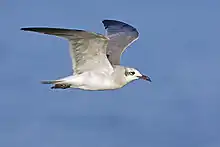 | |
| Laughing gull in flight | |
| Call | |
| Scientific classification | |
| Kingdom: | Animalia |
| Phylum: | Chordata |
| Class: | Aves |
| Order: | Charadriiformes |
| Family: | Laridae |
| Genus: | Leucophaeus |
| Species: | L. atricilla |
| Binomial name | |
| Leucophaeus atricilla | |
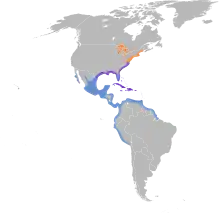 | |
| Synonyms | |
|
Larus atricilla Linnaeus, 1758 | |
Name
The genus name Leucophaeus is from Ancient Greek λευκός : leukós, "white", and φαιός : phaios, "dusky". The specific atricilla is from Latin ater, "black", and cilla, "tail". Linnaeus appears to have misread his note atricapilla (black-haired), which would have been much more appropriate for this black-headed, but white-tailed, bird.[2]
Range
It breeds on the Atlantic coast of North America, the Caribbean, and northern South America. Northernmost populations migrate farther south in winter, and this species occurs as a rare vagrant to western Europe. The laughing gull's English name is derived from its raucous kee-agh call, which sounds like a high-pitched laugh "ha... ha... ha...".[3]
Laughing gulls breed in coastal marshes and ponds in large colonies. The large nest, made largely from grasses, is constructed on the ground. The three or four greenish eggs are incubated for about three weeks.
Description
This species is easy to identify. It is 36–41 cm (14–16 in) long with a 98–110 cm (39–43 in) wingspan and a weight range[4] of 203–371g (7.2-13.1 oz). The summer adult's body is white apart from the dark grey back and wings and black head. Its wings are much darker grey than all other gulls of similar size except the smaller Franklin's gull, and they have black tips without the white crescent shown by Franklin's. The beak is long and red. The black hood is mostly lost in winter.
Laughing gulls take three years to reach adult plumage. Immature birds are always darker than most similar-sized gulls other than Franklin's. First-year birds are greyer below and have paler heads than first-year Franklin's, and second-years can be distinguished by the wing pattern and structure.
Subspecies
The two subspecies are:[5]
- L. a. megalopterus – (Bruch, 1855): coastal southeast Canada, eastern & southern United States, Mexico & Central America
- L. a. atricilla – (Linnaeus, 1758): West Indies to Venezuelan islands
Like most other members of the genus Leucophaeus, the laughing gull was long placed in the genus Larus. The present placement in Leucophaeus follows the American Ornithologists' Union.[6][7]
Gallery
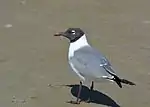 Mating plumage includes black head and red bill
Mating plumage includes black head and red bill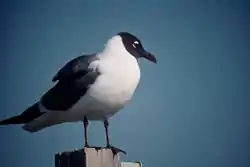 Definitive alternate plumage
Definitive alternate plumage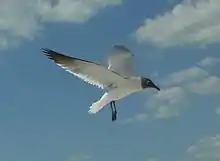 Adult in mid-May (definitive alternate plumage)
Adult in mid-May (definitive alternate plumage) Laughing gull, alternate plumage, North Carolina, US, 2016
Laughing gull, alternate plumage, North Carolina, US, 2016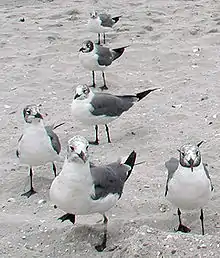 Adult in winter (definitive basic plumage)
Adult in winter (definitive basic plumage)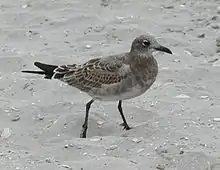 Juvenile
Juvenile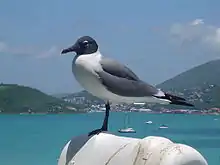 Adult at St. Thomas, Virgin Islands (definitive alternate plumage)
Adult at St. Thomas, Virgin Islands (definitive alternate plumage)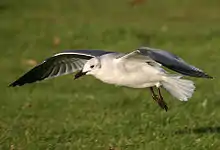 Vagrant in definitive basic plumage in the UK in late 2005
Vagrant in definitive basic plumage in the UK in late 2005 Preparing to land on beach
Preparing to land on beach_de_los_Roques_Venezuela_000.jpg.webp) Los Roques Venezuela
Los Roques Venezuela Egg, Collection Museum Wiesbaden
Egg, Collection Museum Wiesbaden
References
- BirdLife International (2012). "Larus atricilla". IUCN Red List of Threatened Species. 2012. Retrieved 26 November 2013.CS1 maint: ref=harv (link)
- Jobling, James A (2010). The Helm Dictionary of Scientific Bird Names. London: Christopher Helm. pp. 59, 224. ISBN 978-1-4081-2501-4.
- "Laughing Gull (Larus atricilla)". Handbook of the Birds of the World. Retrieved 29 October 2018.
- "Laughing Gull Identification, All About Birds, Cornell Lab of Ornithology". www.allaboutbirds.org. Retrieved 2020-09-25.
- "Laughing Gull (Larus atricilla)".
- "Check-list of North American Birds". North American Classification Committee. American Ornithologists' Union. Retrieved 2009-05-26.
- Remsen, J. V. Jr.; C. D. Cadena; A. Jaramillo; M. Nores; J. F. Pacheco; M. B. Robbins; T. S. Schulenberg; F. G. Stiles; D. F. Stot; K. J. Zimmer. "A classification of the bird species of South America". South American Classification Committee. American Ornithologists' Union. Archived from the original on 2009-03-02. Retrieved 2009-05-26.
External links
| Wikimedia Commons has media related to Laughing gull. |
| Wikispecies has information related to Leucophaeus atricilla. |
- Laughing Gull - Larus atricilla - USGS Patuxent Bird Identification InfoCenter
- Laughing Gull Species Account - Cornell Lab of Ornithology
- Field Guide on Flickr
- Laughing Gull Bird Sound at Florida Museum of Natural History
- "Laughing Gull media". Internet Bird Collection.
- Laughing Gull photo gallery at VIREO (Drexel University)
- Interactive range map of Leucophaeus atricilla at IUCN Red List maps

